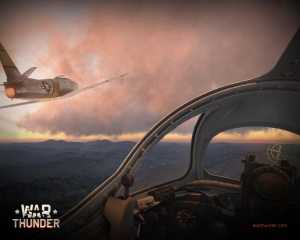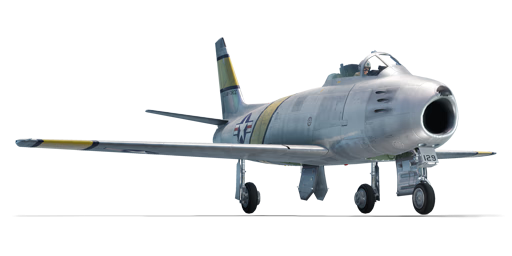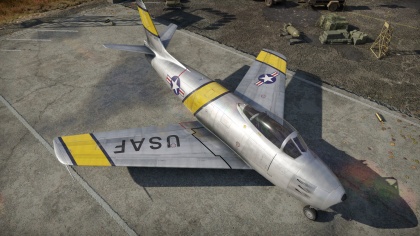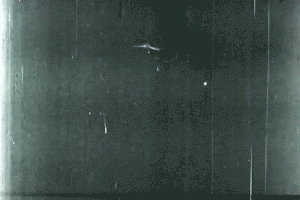Difference between revisions of "F-86A-5"
m (Edits.) |
(Edits.) |
||
| Line 14: | Line 14: | ||
[[File:GarageImage_{{PAGENAME}}.jpg|420px|thumb|left]] | [[File:GarageImage_{{PAGENAME}}.jpg|420px|thumb|left]] | ||
{{break}} | {{break}} | ||
| − | The '''{{Specs|name}}''' is a Rank {{Specs|rank}} American jet fighter {{Battle-rating}}. | + | The '''{{Specs|name}}''' is a Rank {{Specs|rank}} American jet fighter {{Battle-rating}}. This fighter has been in the game since the start of the Open Beta Test prior to Update 1.27. |
== General info == | == General info == | ||
| Line 235: | Line 235: | ||
The F-86A-5 is the first operational variant of the F-86. It is powered by the General Electric J47 engine and includes slats on the leading edge of the wing derived from the Messerschmitt Me 262 to increase low-speed performance. It is armed with six M3 .50 (12.7 mm) electrically boosted machine guns firing at 1,200 rounds per minute. It can carry eight 5" rockets, 2,000 lb of bombs, or a pair of external fuel tanks that can be jettisoned in-flight to increase performance in combat. While most of the F-86As had a Mark 18 manual ranging-computing gun sight, the last 24 F-86A-5-NAs were equipped with the A-1CM gun sight, which used radar to automatically compute a target's range. This later became standard on the F-86E. | The F-86A-5 is the first operational variant of the F-86. It is powered by the General Electric J47 engine and includes slats on the leading edge of the wing derived from the Messerschmitt Me 262 to increase low-speed performance. It is armed with six M3 .50 (12.7 mm) electrically boosted machine guns firing at 1,200 rounds per minute. It can carry eight 5" rockets, 2,000 lb of bombs, or a pair of external fuel tanks that can be jettisoned in-flight to increase performance in combat. While most of the F-86As had a Mark 18 manual ranging-computing gun sight, the last 24 F-86A-5-NAs were equipped with the A-1CM gun sight, which used radar to automatically compute a target's range. This later became standard on the F-86E. | ||
| + | |||
| + | === In-game description === | ||
| + | |||
| + | "An all-metal monoplane jet fighter with swept wings. | ||
| + | |||
| + | The development of the Sabre began in the autumn of 1944 as a modification of the NA-134 shipboard fighter. In November 1944, North-American presented its plan for a daytime fighter to the United States Army Air Forces (USAAF): the NA-140 model, based on the NA-134 and later given the designation of XP-86. It was decided in the design process that the XP-86 would feature the more promising swept wings instead of straight ones. The prototype Sabre XP-86, built with swept wings, first flew on October 1, 1947. | ||
| + | |||
| + | The first production model of the Sabre was the Р-86А (manufacturer number NA-151). In June 1948, the aircraft was given the new designation of F-86A. It was fitted with a General Electric J47-GE-1 (-3, -7) turbojet engine producing 2,360 kg of thrust. | ||
| + | |||
| + | The aircraft's armament consisted of six 12.7mm Browning M3.5 machine guns with 1,800 total rounds of ammunition. The distinctive features of the production model were a curved windscreen and flaps over the machine gun firing ports, which could be closed by means of an electric motor. The first production Р-86А-1 took off on 20 May 1948. Most of the F-86А-1s were used to perform various tests and were not delivered to the front. | ||
| + | |||
| + | The F-86A-5 (NA-151) was the first real combat Sabre with a J47-GE-7 engine. It was produced for the first time on February 23, 1949. This model had a new windscreen, and the closeable flaps of the machine gun firing ports were removed to simplify maintenance. The cockpit canopy could be jettisoned if necessary. Two 780-liter fuel tanks could be mounted on the underwing pylons. Instead of fuel tanks, the aircraft could carry a combat load, which usually consisted of two 100-lb (45-kg), 500-lb (227-kg) or 1,000-lb (454-kg) bombs, two 375-kg tanks filled with napalm, or two 220-kg bomb clusters. Guide rails could also be mounted to hold eight unguided 5-inch HVAR rockets under each wing. | ||
| + | |||
| + | A contract to deliver the next batch of the F-86As was signed in May 1948. These aircraft were still designated as F-86A-5s but they were named NA-161s at the plant, as they had a number of differences from previous series. In particular, they were equipped with a J47-GE-13 engine. Deliveries of this batch began in October 1949 and were finished in December of the following year. | ||
| + | |||
| + | The last 24 F-86A-5s had a new A-1CM sight coupled with an AN/APG-30 radar ranging unit. The planes originally equipped with the А-1СМ were designated as F-86A-6s, and those retrofitted on site were designated as F-86A-7s. | ||
| + | |||
| + | The first USAAF military unit that received the F-86A was the 94th FS (Fighter Squadron) of the 1st FW (Fighter Wing). The pilots in the unit nicknamed the new fighter the Sabre. | ||
| + | |||
| + | The F-86A fighters took part in the Korean War, making their first combat flight on December 17, 1950. Compared to its main opponent, the Mikoyan-Gurevich MiG-15 fighter, the Sabre's flight characteristics were somewhat better at low altitude, but it was inferior to the MiG in its rate of climbing, service ceiling, speed at high altitude, and armament. However, the Sabre's main advantage was its sight, equipped with a radar ranging unit that enabled more accurately aimed fire when maneuvering at high speeds. | ||
| + | |||
| + | The total number of the F-86A aircraft constructed was 554, and they served only with the USAF and the Air National Guard (ANG)." | ||
== Media == | == Media == | ||
Revision as of 17:01, 14 May 2019
Contents
| This page is about the aircraft F-86A-5. For other uses, see F-86 (Family). |
Description
The F-86A-5 Sabre is a Rank V American jet fighter
with a battle rating of 7.7 (AB), 8.0 (RB), and 8.7 (SB). This fighter has been in the game since the start of the Open Beta Test prior to Update 1.27.
General info
Flight Performance
The F-86A-5 has the weakest engine of all Sabre variants, and generally, the engine is weak compared to other top rank jets (F-86F, CL-13, MiG-17, MiG-15bis etc); thus the slow acceleration, lower top speed than all other Sabres and the low rate of climb for a top rank jet. However, it is the best-turning Sabre in the game and the one with the fastest roll rate. But do not turn at any cost unless it's an emergency! The F-86A-5 bleeds speed in vertical flight and horizontal turns very quickly and struggle to regain the energy it had unless there are no enemies in the area to deal with. Remember this: a slow Sabre is a vulnerable Sabre! Despite all of that, it is still faster than the MiG-15, MiG-15bis and many other enemies in top speed.
| Characteristics | |||||||
|---|---|---|---|---|---|---|---|
| Stock | |||||||
| Max Speed (km/h at 0 m - sea level) |
Max altitude (meters) |
Turn time (seconds) |
Rate of climb (meters/second) |
Take-off run (meters) | |||
| AB | RB | AB | RB | AB | RB | ||
| 1,081 | 1,071 | 14,000 | 25.4 | 25.9 | 30.8 | ??.? | 700 |
| Upgraded | |||||||
| Max Speed (km/h at 0 m - sea level) |
Max altitude (meters) | Turn time (seconds) | Rate of climb (meters/second) |
Take-off run (meters) | |||
| AB | RB | AB | RB | AB | RB | ||
| 1,105 | 1,093 | 14,000 | 22.7 | 24.0 | 46.2 | 38.1 | 700 |
Details
| Features | ||||
|---|---|---|---|---|
| Combat flap | Take-off flap | Landing flap | Air brakes | Arrestor gear |
| ✓ | ✓ | ✓ | ✓ | X |
| Limits | ||||
|---|---|---|---|---|
| Wing-break speed (km/h) |
Gear limit (km/h) |
Combat flap (km/h) |
Max Static G | |
| + | - | |||
| 1,118 | 350 | 620 | ~13 | ~8 |
| Optimal velocities | |||
|---|---|---|---|
| Ailerons (km/h) |
Rudder (km/h) |
Elevators (km/h) |
Radiator (km/h) |
| < 850 | < 600 | < 680 | > 250 |
| Compressor (RB/SB) | ||
|---|---|---|
| Setting 1 | ||
| Optimal altitude | 100% Engine power | WEP Engine power |
| 0 m | 2250 kgf | No WEP |
Survivability and armour
- 38 mm Bulletproof glass - Front Windshield
- 6.35 mm Steel - Nose armour x 2
- 20 mm Steel - Pilot's headrest
- 12.7 mm Steel - Back of pilot's seat
Armaments
Offensive armament
The F-86A-5 is armed with:
- 6 x 12.7 mm Browning M3 machine guns, nose-mounted (300 rpg = 1,800 total)
Suspended armament
The F-86A-5 can be outfitted with the following ordinance:
- Without payload
- 16 x 127 mm HVAR rockets
- 2 x 1,000 lb AN-M65A1 Fin M129 bombs (2,000 lb total)
Usage in battles

The F-86A-5 should be played as a strict Boom & Zoom plane due to the fact that simple turns make it bleed a lot of speed. Gain some speed after takeoff (750 - 800 kph or 466 - 497 mph) then zoom up to 3,000 mm/9,843 ft then turn to the centre after you're done zoom side-climbing. Next, you pick your targets. Dive, engage, zoom up smoothly (to not lose a lot of speed) then rinse and repeat. If there are multiple enemies above you, don't engage and keep flying straight. If there is one enemy above you in the vicinity, you can engage, but don't pull up hard or you will lose a lot of speed in the process! Do it smoothly. If you are generally low on speed and you can escape from enemies, keep flying straight until you're fast, zoom up then loop around and keep flying straight at the altitude you went up to then resume the strict Boom & Zoom procedure.
The F-86A-5 is not an air superiority fighter, it's more of a support plane despite being a Sabre. Tactics explained in "General playstyle".
All top rank jets are a threat. All of them have better performance overall especially in acceleration, climb rate and energy retention.
For those who may have a F-86A-5 on their tail, if you're in an emergency (a situation where nothing that was explained works), resort to defensive flying. The defensive flying capabilities of the A-5 Sabre are very high and extremely good due to its roll rate. Most of the time, top rank jet pilots will Boom & Zoom you which can be a problem for you, however, if they decide to stick around and dogfight you, you will have the advantage.
Modules
| Tier | Flight performance | Survivability | Weaponry | ||
|---|---|---|---|---|---|
| I | Fuselage Repair | Compressor | Offensive 12 mm | ||
| II | New Boosters | Airframe | FRC mk.2 | ||
| III | Wings Repair | Engine | New 12 mm MGs | ||
| IV | G-Suit | Cover | FLBC mk.1 | ||
Pros and cons
Pros:
- Very fast roll rate
- Leading edge slats which improve low-speed manoeuvrability
- Nose mounted weaponry
- Good zooming ability
- Good diving ability
- Best turning Sabre
- 12.7 mm M3 Browning .50 calibre guns are very effective weapons
Cons:
- Poor sustained climb rate
- Slow acceleration for a top rank jet
- Loses a lot of speed in turns
- Slow compared to its enemies
- Very hard to get guns on target in horizontal due to weak rudder control
History
The F-86 is considered one of the best fighter jets of the Korean War. It is the most-produced Western fighter, with almost 10,000 aircraft produced by the US, Australia, Canada (as the re-engined CL-13), Italy, and Japan.
The F-86 was developed by North American Aviation, the creator of the venerable P-51 Mustang. The XP-86 prototype was created to meet the USAF requirement for a high-altitude escort fighter. It was derived from the Navy's FJ-1 Fury, a transitional fighter jet that borrowed the wings, tail surfaces and canopy from the P-51D. The XP-86 was under threat of cancellation because the XP-80 and XP-84 had similar performance characteristics and were farther ahead in development. However, North American designers made a radical change to the design and replaced the straight wing with a swept wing, which was shown by seized German research to greatly reduce drag and increase performance at high speed. The resulting performance boost was so significant that the swept-wing prototype of the XP-86 was supposedly able to break the sound barrier in a dive a few days before Chuck Yeager made his official attempt.
The F-86A-5 is the first operational variant of the F-86. It is powered by the General Electric J47 engine and includes slats on the leading edge of the wing derived from the Messerschmitt Me 262 to increase low-speed performance. It is armed with six M3 .50 (12.7 mm) electrically boosted machine guns firing at 1,200 rounds per minute. It can carry eight 5" rockets, 2,000 lb of bombs, or a pair of external fuel tanks that can be jettisoned in-flight to increase performance in combat. While most of the F-86As had a Mark 18 manual ranging-computing gun sight, the last 24 F-86A-5-NAs were equipped with the A-1CM gun sight, which used radar to automatically compute a target's range. This later became standard on the F-86E.
In-game description
"An all-metal monoplane jet fighter with swept wings.
The development of the Sabre began in the autumn of 1944 as a modification of the NA-134 shipboard fighter. In November 1944, North-American presented its plan for a daytime fighter to the United States Army Air Forces (USAAF): the NA-140 model, based on the NA-134 and later given the designation of XP-86. It was decided in the design process that the XP-86 would feature the more promising swept wings instead of straight ones. The prototype Sabre XP-86, built with swept wings, first flew on October 1, 1947.
The first production model of the Sabre was the Р-86А (manufacturer number NA-151). In June 1948, the aircraft was given the new designation of F-86A. It was fitted with a General Electric J47-GE-1 (-3, -7) turbojet engine producing 2,360 kg of thrust.
The aircraft's armament consisted of six 12.7mm Browning M3.5 machine guns with 1,800 total rounds of ammunition. The distinctive features of the production model were a curved windscreen and flaps over the machine gun firing ports, which could be closed by means of an electric motor. The first production Р-86А-1 took off on 20 May 1948. Most of the F-86А-1s were used to perform various tests and were not delivered to the front.
The F-86A-5 (NA-151) was the first real combat Sabre with a J47-GE-7 engine. It was produced for the first time on February 23, 1949. This model had a new windscreen, and the closeable flaps of the machine gun firing ports were removed to simplify maintenance. The cockpit canopy could be jettisoned if necessary. Two 780-liter fuel tanks could be mounted on the underwing pylons. Instead of fuel tanks, the aircraft could carry a combat load, which usually consisted of two 100-lb (45-kg), 500-lb (227-kg) or 1,000-lb (454-kg) bombs, two 375-kg tanks filled with napalm, or two 220-kg bomb clusters. Guide rails could also be mounted to hold eight unguided 5-inch HVAR rockets under each wing.
A contract to deliver the next batch of the F-86As was signed in May 1948. These aircraft were still designated as F-86A-5s but they were named NA-161s at the plant, as they had a number of differences from previous series. In particular, they were equipped with a J47-GE-13 engine. Deliveries of this batch began in October 1949 and were finished in December of the following year.
The last 24 F-86A-5s had a new A-1CM sight coupled with an AN/APG-30 radar ranging unit. The planes originally equipped with the А-1СМ were designated as F-86A-6s, and those retrofitted on site were designated as F-86A-7s.
The first USAAF military unit that received the F-86A was the 94th FS (Fighter Squadron) of the 1st FW (Fighter Wing). The pilots in the unit nicknamed the new fighter the Sabre.
The F-86A fighters took part in the Korean War, making their first combat flight on December 17, 1950. Compared to its main opponent, the Mikoyan-Gurevich MiG-15 fighter, the Sabre's flight characteristics were somewhat better at low altitude, but it was inferior to the MiG in its rate of climbing, service ceiling, speed at high altitude, and armament. However, the Sabre's main advantage was its sight, equipped with a radar ranging unit that enabled more accurately aimed fire when maneuvering at high speeds.
The total number of the F-86A aircraft constructed was 554, and they served only with the USAF and the Air National Guard (ANG)."
Media
Excellent additions to the article would be video guides, screenshots from the game, and photos.
See also
Links to the articles on the War Thunder Wiki that you think will be useful for the reader, for example:
- reference to the series of the aircraft;
- links to approximate analogues of other nations and research trees.
External links
Paste links to sources and external resources, such as:
- topic on the official game forum;
- encyclopedia page on the aircraft;
- other literature.
| USA jet aircraft | |
|---|---|
| Fighters | |
| F9F | F9F-2 · F9F-5 · F9F-8 |
| F-80 | F-80A-5 · F-80C-10 |
| F-84 | F-84B-26 · F-84F · F-84G-21-RE |
| F-86 | F-86A-5 · F-86F-25 · F-86F-2 · F-86F-35 |
| F-89 | F-89B · F-89D |
| F-100 | F-100D |
| F-104 | F-104A · F-104C |
| F-4 | F-4C Phantom II · F-4E Phantom II · F-4J Phantom II · F-4S Phantom II |
| F-5 | F-5A · F-5C · F-5E · F-20A |
| F-8 | F8U-2 · F-8E |
| F-14 | F-14A Early · ▄F-14A IRIAF · F-14B |
| F-15 | F-15A · F-15C MSIP II · F-15E |
| F-16 | F-16A · F-16A ADF · F-16C |
| Other | P-59A · F2H-2 · F3D-1 · F3H-2 · F4D-1 · F11F-1 |
| Strike Aircraft | |
| FJ-4 | FJ-4B · FJ-4B VMF-232 |
| A-4 | A-4B · A-4E Early |
| A-7 | A-7D · A-7E · A-7K |
| AV-8 | AV-8A · AV-8C · AV-8B Plus · AV-8B (NA) |
| A-10 | A-10A · A-10A Late · A-10C |
| F-111 | F-111A · F-111F |
| Other | A-6E TRAM · F-105D · F-117 |
| Bombers | |
| B-57 | B-57A · B-57B |






